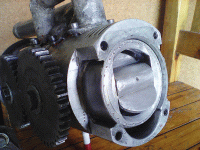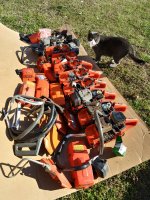The scavenging starts with a higher pressure just before the transfer ports (outside the cylinder).
At the beginning of the scavenging the fresh gas bursts into the cylinder (which enables an earlier opening of the transfer relative to the opening of the exhaust; the transfer port opens after the exhaust port).
The scavenging starts “positive”: from the opening of the transfer port to the BDC (Bottom Dead Center), the piston (with the tilting valve sealing its back end, and due to the small dead volume in the scavenge pump) displaces the air-fuel mixture into the cylinder positively (it resembles with the exhaust cycle of the 4-stroke engines: no matter what the pressure in the exhaust manifold is, the piston will push positively the burnt gas outside the cylinder).
Things change near the BDC wherein the tilting valve opens.
Now the space inside the piston (i.e. the “crankcase” of the OPRE Tilting) is free to communicate with the cylinder through the open scavenge port, and the scavenging turns from “positive” to “inertial”.
With the inertia of the fast moving gas “column” in the transfer - cylinder - exhaust, the transfer continuous strong till the closing of the transfer port, sucking gas from the space inside the piston and the inlet port.
At the end of the transfer, with the flow of the fresh gas from inside the piston towards the “scavenge pump” (and from the inlet port towards the space inside the piston) already strong, the filling (or overfilling) of the scavenge pump space with fresh gas continues uninterrupted till the closing of the tilting valve near the TDC. After the TDC the already established flow of fresh gas from the inlet port into the “crankcase” continues uninterrupted, while at the same time the gas trapped into the scavenge pump undergoes a compression by the outwards moving piston.
The bigger the tilting valves, the better the breathing at high revs










